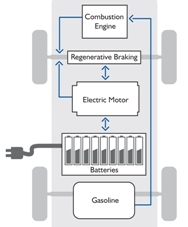About Plug-in Electric Vehicles
 |
“Plug-in electric vehicles,” like all electric drive vehicles, use electricity to move vehicle’s wheels. Some, or all, of that electricity comes from the grid -- from “plugging in.”
How do they work?
Plug-in electric vehicles come in many forms, or configurations. With battery electric vehicles, all of the electricity comes from the grid. Hybrids with plug-in capability use a combination of grid electricity, regenerative energy from braking, and power from another onboard source, such as an internal combustion engine or fuel cell.
In addition, plug-in hybrids can be configured to operate serially, or in a blended fashion. In a serial configuration, the vehicle runs on electricity alone at some points, like starting, and uses its other power source alone at others, for example, when accelerating. Alternatively, a plug-in hybrid may be configured for blended operation, i.e., the battery and the conventional engine operate together.
An extended-range battery electric vehicle uses an internal combustion engine or fuel cell to recharge the battery, but not to move the wheels.
In addition to the variety of ways that plug-in technology can be configured, it can also be applied to a variety of vehicles. Plug-in electric vehicles are being developed and used in diverse applications – including commuter buses and utility trucks, full sized passenger cars, high performance roadsters and low-speed vehicles.
Why do we need them?
What plug-in electric vehicles all have in common is the ability to use electricity from the grid to displace the petroleum used for transportation. Currently, 96% of U.S. transportation is fueled by oil. More that half of that oil is imported, often from hostile nations. Policymakers and the public are increasingly aware that this dependence on oil is a threat to our national security.
Oil dependence also poses
a threat to our economic security, as price volatility and supply
insecurity impacts markets and consumers.
Plug-in vehicles are also
an important part of a climate change strategy. Displacing petroleum with
electricity reduces emissions from the transportation sector. Even with
today’s mix of grid electricity sources, which is dominated by coal,
the use of grid power instead of petroleum is a net benefit for the
environment. As grid-power becomes even cleaner over time, the greenhouse
gas reduction and other air quality benefits of plug-in vehicles will be
even greater.
What are we doing to bring them into the market?
The private and public sectors are working to
accelerate the commercialization of plug-in options throughout the
transportation sector. Major vehicle manufacturers and battery companies,
as well as small start ups, are racing to make the necessary technology
advances. The federal government is supporting research, development and
deployment. States and local government entities are implementing programs
and incentives for plug-in vehicles.
A continuing commitment to, and
support for, industry and government efforts can increase the
electrification of transportation and move the Untied States toward a
sustainable transportation sector, that invigorates, not undermines, our
national security, our environment or our economy.
Advantages
of Plug-in Vehicles:
-Reduced fuel consumption and tailpipe
emissions
-Cleaner electric energy through advances in natural gas and
coal gasification
-Optimized fuel efficiency and
performance
-Recovered energy from regenerative braking
-Unchanged
gas station infrastructure
-Grid connection potential
-"Home based"
battery recharging at a fraction of the cost of petroleum
equivalent
-Pure zero emission capability
-Even lower fueling costs
compared to battery sustaining hybrids
-Possible use in secondary
markets for used batteries and reduced
waste
Challenges:
-Cost and complexity of
two powertrains
-Component availability--batteries, powertrains, power
electronics
-Higher initial cost
-Cost of batteries and battery
replacement
-Added weight
More information:


